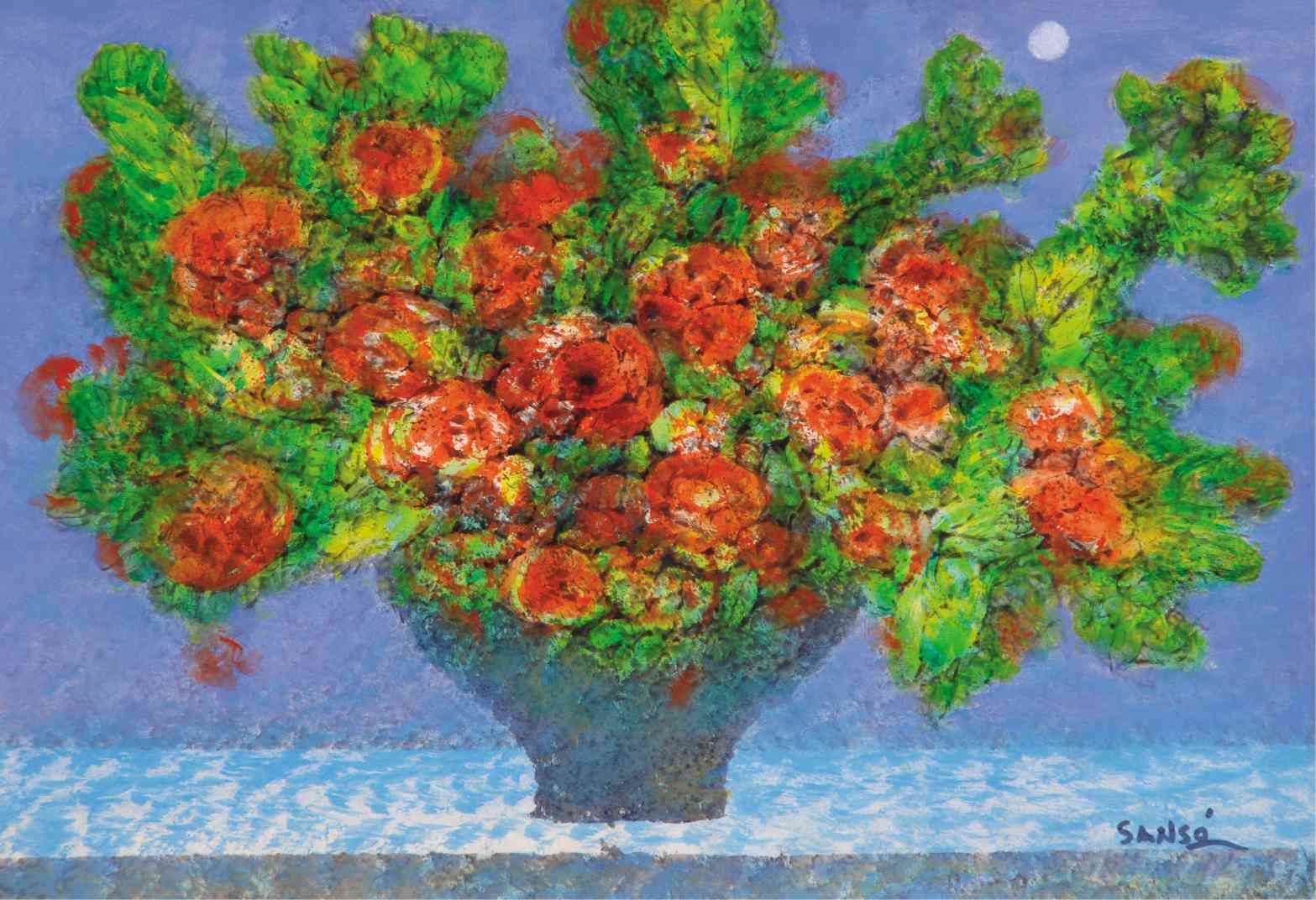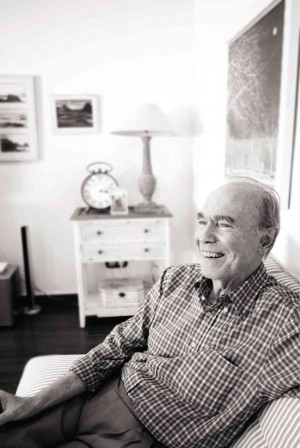
In celebration of Juvenal Sansó’s 65th year in art, Fundacion Sansó will hold an exhibit of rare Sansó works from the 1980s and the 1990s, titled “Rare and Essential Sansó.”
The exhibit opens Sept. 12, 6 p.m., at the Manila A and B rooms at Shangri-La Makati Hotel.
Fundacion Sansó will establish art scholarship programs for artists and education programs on the arts.
Among the works to be exhibited are from his bamboo and baklad series; golden-dawn and seascapes, Brittany, flowers-in-a-vase, summer and water-landscape series.
An exclusive interview with Duffie Hufana Osental for the Inquirer:
You’ve recently just settled down in the Philippines. After so many years in Europe, why did you decide to come back?
Well, I first came to the Philippines at age 4, so it was like I was born here. I arrived with my parents [from Catalonia, Spain] and they liked it very much [here].
My father established a wrought-iron business called Arte Español and it went on until the Japanese came in [during World War II] and destroyed the factory and store. I ended up being a ticket collector on a bus, until my father was able to re-establish Arte Español, because we were so poor.
I was in Europe for 50 years, but while I lived there, I often missed Manila. But I came back for the simple reason that to me this is home.
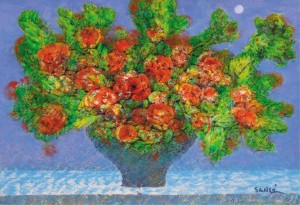
No one forced me to come back. My father never went back to Spain. He died in the Philippines. I have many friends here. Although on occasion, I still go back to Europe since I have a house in Malaga, Spain.
Your family owned a wrought-iron business and your father designed many of the pieces. Did this influence your art?
Yes, very much. My father was a sculptor. Many of his designs were in demand, starting with Malacañang after the war, and throughout the Philippines. We had commissions for many things and we made them.
Why did you want to become an artist?
Well, I’ve always loved drawing. And working at Arte Español required a lot of drawing. My parents got me a private art tutor, Alejandro Celis. Very nice man. Eventually, he said that I could not go on studying alone and that I had to go to UP.
After the war, you went to the University of the Philippines College of Fine Arts. What was the art scene like?
The dean was [National Artist Fernando] Amorsolo. Nice man. The others were also great. [National Artist Guillermo] Tolentino was also there, a magnificent sculptor.
But we had a problem with space. UP was practically destroyed after the war. UP was then in Manila, on Padre Faura near Philippine Women’s University.
How did the war influence your art?
Because of the war, everyone sort of saw the other side of humanity.
I was tortured by the Japanese. This was why early in my career I painted a lot of dramatic, dark subjects. This is why I could not go around being an Amorsolo, painting beautiful things. I admired him very much and he influenced me a lot. And many people copied him, as they still do now.
But there’s a limit to what you can do with that, and they weren’t facing the real problems of the moment.
They were thinking of the pretty dalaga and fields and guitarists. That was what was great about Amorsolo. He didn’t force his students to become little Amorsolos. I had to bring out what was inside of me.
This resulted in what they call my Black Period with “The Sorcerer,” followed by “The Incubus.” The Art Association of the Philippines (AAP) gave me First Prize in Oil and Watercolor categories. It was in 1950 and ’51.
You worked on many subjects and mediums. From your Black Period, you have your Brittany series, abstracts, landscapes, and you’ve even worked with textile. Can you trace the development of your art?
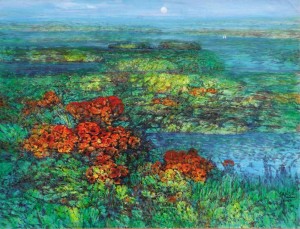
By being sincere with what one is doing, one can dig out a lot. Of course, there was the war. I was not and could not be like Amorsolo, or forever making paintings of kids playing or rural scenes!
I really needed to spew things out of my system. Up to now, sometimes I wake up and think I’m still in the war!
I spent 24 summers in Brittany and was made part of the Yves le Dantec family, where I was always welcome. That was when I started my Brittany series.
The textiles came in the ’60s when a friend suggested I submit some works to design houses. Balenciaga, Bianchini-Ferier, Synergie and some of the major fashion houses liked my work.
Those works, I believe, became the foundation for some of the abstract art I have done.
Some people have labeled you as an expressionist. Do you agree?
Yes! My art really gives a picture of what’s going on inside [of me]. I really had to spew my feelings.
Just a few days before the liberation of Manila, a bomb fell on the house we were in. It threw me across the room and I lost 80 percent of my hearing in one ear. It has also affected my sense of balance forever. And there are so many levels to it.
I can say I definitely paint from the heart. If I had tried to impress some people with my earlier works, making those dark paintings was the wrong way to impress people! (Laughs) Even business-wise, it was not good. I was painting very expressionist things. Slowly I moved out of that period and I started something else.
Is there any Filipino painter you admire?
I like [National Artist Cesar] Legaspi. But I don’t think he influenced me directly. We got along very well, Legaspi and myself. But he was an older man.
I think he was in advertising then. Then there was his successful art practice. He was earning good income then, and I was not making any money at all!
After UP, you went to Europe—particularly Rome and, later, Paris. What was it about Europe that attracted you?
Well, I had a choice to go to the US or Europe. I preferred Europe for the simple reason that I was more familiar with the works of European masters, so I wanted something I had studied, for a little continuity. And also going to the States cost a lot of money at the time. Going to Europe cost not even one-third of that.
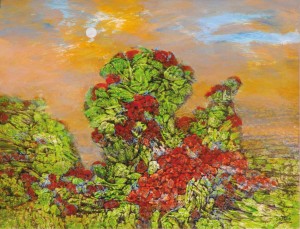
Another reason is that the museums in Europe were fantastic and I learned a lot from them.
An interesting story is that I took my painting of the blind man (“The Incubus”). I actually still have it. But anyway, I took it to Italy. I did not speak Italian and the professors of the school [Academia di belle Arti] where I enrolled were discussing whether or not to accept me. I went there with my painting tucked under my arm, and that painting was really my passport, both in Rome and in Paris [Ecole des Beaux Arts].
When I showed my painting to the professors, they began talking among themselves and I got to understand bits and pieces. They were impressed. Some of the faculty were concerned that I didn’t speak Italian.
But in Rome, the majority addressed that point by saying that if one could paint hands [like in the painting “Incubus”], he could learn Italian.
It was the same in Paris, where they felt that “if he can paint like that, he can learn French.”
What’s the story behind your Brittany series?
Brittany was a wonderful chapter in my life. It all started with a coincidence. I was living in Paris at the time. I was a student with a small room.
I wanted a beer, and around five minutes away was a bar. I didn’t know any of the French brands.
I was trying to get a beer, and there was a gentleman there who would become almost like a second father to me. His name was Yves Les Dantec and he turned out to be the son-in-law of the great painter Georges Rouault.
Rouault was one of the greatest painters in the world, I think.
Anyway, Yves was there, giving his beer order and asked for a beer for me.
I knew a little French, so we started chatting. When I told him I was studying at Fine Arts, he got very interested. Eventually, he invited me to show me the studio of Georges Rouault and I was star-struck!
Anyway, I formed a good friendship with Yves. He was a newspaperman who was a prisoner of war in a German concentration camp. He learned German so well that this facility with the language eventually allowed him to escape. He even studied law in German! It wasn’t just tsamba-tsamba. Fantastic fellow.
That day we met, when he found out I was studying painting, he wanted to see what I did. I took him to my apartment and that was that.
But the essential part was Yves was a Breton. He took me to Brittany for the first time to sketch and draw the landscape. I would go there every summer, and I became part of the family. I had the advantage of knowing more languages than he did, so I was useful to him when he traveled! (Laughs)
I found a lot of peace in France, and I think it helped me deal with my experience during the war.
What is your goal with this foundation you’re putting up?
I have been offered the idea. My aim is really education. I want to help younger people. Hopefully Fundacion Sansó can provide art education to the art- loving public as well as scholarships to deserving artists.
But we’re also planning a museum. I want it very much, of course. There are many possibilities. I can put drawings, etchings, expressionist works, and my other paintings.
I have actually kept a number of pieces from the different stages of my life, which I would like to leave with the museum.
Then there are also the paintings from private collections. And we can also invite other artists, local and maybe artists from Europe to exhibit.
There are lots of ideas, but the museum has to be managed by someone other than myself. (Smiles) Vanity is an ugly customer!
Why is this project called “Rare and Essential Sansó”?
I didn’t only just want to come home physically, but I also wanted my artworks to come home with me.
I have these pieces done in the ‘80s and the ’90s, from my days in Paris and which I brought to Malaga, Spain. Since there are plans to put up the museum, I thought it would be best to start bringing my collection back to Manila.
Since my strokes and styles have evolved since the 1980s and the ’90s, I think that explains “rare.”
Thematically, the works include those which form part of my basic and major themes—baklad, bamboo, golden dawnscapes, Brittany and my flowers series—hence the word “essential.”
What else does the future have in store for you?
There’s the foundation and the museum. Much will depend on the shape of it. And I’m still painting, of course. I paint every day, especially on Sundays! Art is not a business for me; it’s a passion, and if I can still push myself, I’ll push. I’ll continue [until] my sight goes on. And if I can’t do one thing, I’ll do another.
Age is no joke [Sansó turns 84 this year], but physically I’m doing fine.
After Sept. 12, “Rare and Essential Sansó” will be transferred to Galerie Raphael in Serendra Mall and Galleria Nicolas at 3/F, Glorietta 5, Sept. 13-25. Call 7239418, 7239253; visit www.galeriejoaquin.com.

